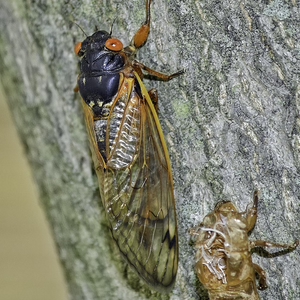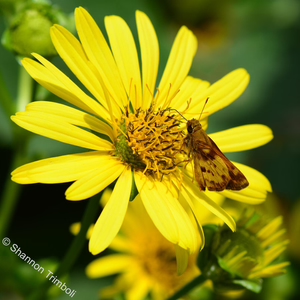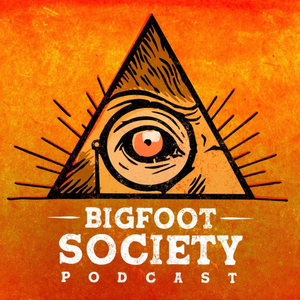
Tracking the Periodical Cicadas with Dr. Gene Kritsky
04/29/21 • 66 min
For many of us, the rhythmic chatter of annual cicadas is a natural part of every summer. But then... every once in a while... the trees explode in a deafening chorus of periodical cicadas. Periodical cicadas will spend over a decade as nymphs underground before emerging and maturing into adults. The adults only live a few weeks, but what an impression they make while they are here!
In this episode of the Backyard Ecology podcast, we talk with Dr. Gene Kritsky. Gene is the Dean of the School of Behavioral and Natural Sciences at Mount St, Joseph University in Cincinnati. He is also the author of the book Periodical Cicadas: The Brood X Edition.
During our conversation, Gene talked about the different species of 17-year periodical cicadas, as well as, the difference between broods and species. We also talked about the interesting life history of periodical cicadas and the important roles they play in the local ecosystems when they emerge. In addition, Gene provided tips for anyone who might be a little concerned about any negative impacts that periodical cicadas might have on their trees.
One of the most exciting things Gene shared with us is his research on documenting and mapping the different broods. The idea that whole broods could be missed for centuries or that we have new broods appearing as portions of known broods shift their emergence patterns is fascinating to me. I also love the fact that he has given all of us the opportunity to help document and map the different broods through his Cicada Safari app.
Using the Cicada Safari app, we can help Gene and other researchers gain a better understanding of the distribution of the different broods. With today’s tools and technology, we have the opportunity to easily help create much more detailed and comprehensive maps of the broods than scientists have ever been able to do before. But to it will take all of us working together and documenting what is happening in our own yards and communities. I think that’s exciting and hope we can help grant Gene’s wish to completely overwhelm him with data.
I also appreciate all of the fun and educational resources that are included in the Cicada Safari app and on the Cicada Safari website. Whether you want to learn how to identify the different species, just have some fun making origami cicadas, learn how to dive into the historic records to try and identify overlooked broods in your area, or are looking for potential science fair project ideas, the Cicada Safari website has you covered. Links to the Cicada Safari website, Gene’s book, and other periodical cicada resources he recommended can be found below.
When we recorded this in 2021, Brood X was the periodical cicada emergence that we were looking forward to. However, at least one brood of periodical cicadas emerges somewhere in the country every year. So, no matter when you listen to this episode, it is likely that there will be an emergence somewhere in the U.S. that needs to be documented and mapped.
Links:- Cicada Safari
- Periodical Cicadas: The Brood X Edition
- Other recommended resources
- Backyard Ecology’s website
- My email: [email protected]
- Periodical cicada
- Photo credit: Gene Kritsky, Mount St. Joseph University, all rights reserved
For many of us, the rhythmic chatter of annual cicadas is a natural part of every summer. But then... every once in a while... the trees explode in a deafening chorus of periodical cicadas. Periodical cicadas will spend over a decade as nymphs underground before emerging and maturing into adults. The adults only live a few weeks, but what an impression they make while they are here!
In this episode of the Backyard Ecology podcast, we talk with Dr. Gene Kritsky. Gene is the Dean of the School of Behavioral and Natural Sciences at Mount St, Joseph University in Cincinnati. He is also the author of the book Periodical Cicadas: The Brood X Edition.
During our conversation, Gene talked about the different species of 17-year periodical cicadas, as well as, the difference between broods and species. We also talked about the interesting life history of periodical cicadas and the important roles they play in the local ecosystems when they emerge. In addition, Gene provided tips for anyone who might be a little concerned about any negative impacts that periodical cicadas might have on their trees.
One of the most exciting things Gene shared with us is his research on documenting and mapping the different broods. The idea that whole broods could be missed for centuries or that we have new broods appearing as portions of known broods shift their emergence patterns is fascinating to me. I also love the fact that he has given all of us the opportunity to help document and map the different broods through his Cicada Safari app.
Using the Cicada Safari app, we can help Gene and other researchers gain a better understanding of the distribution of the different broods. With today’s tools and technology, we have the opportunity to easily help create much more detailed and comprehensive maps of the broods than scientists have ever been able to do before. But to it will take all of us working together and documenting what is happening in our own yards and communities. I think that’s exciting and hope we can help grant Gene’s wish to completely overwhelm him with data.
I also appreciate all of the fun and educational resources that are included in the Cicada Safari app and on the Cicada Safari website. Whether you want to learn how to identify the different species, just have some fun making origami cicadas, learn how to dive into the historic records to try and identify overlooked broods in your area, or are looking for potential science fair project ideas, the Cicada Safari website has you covered. Links to the Cicada Safari website, Gene’s book, and other periodical cicada resources he recommended can be found below.
When we recorded this in 2021, Brood X was the periodical cicada emergence that we were looking forward to. However, at least one brood of periodical cicadas emerges somewhere in the country every year. So, no matter when you listen to this episode, it is likely that there will be an emergence somewhere in the U.S. that needs to be documented and mapped.
Links:- Cicada Safari
- Periodical Cicadas: The Brood X Edition
- Other recommended resources
- Backyard Ecology’s website
- My email: [email protected]
- Periodical cicada
- Photo credit: Gene Kritsky, Mount St. Joseph University, all rights reserved
Previous Episode

Growing Native Plants: Insights and Stories from 3 Native Plant Nurseries
Gardening with native plants has been growing in popularity. Some people want to grow native plants for plant conservation purposes or to showcase the diverse, local flora of their region. Others want to grow native plants for the benefits they provide to pollinators and wildlife. Still others are interested in native plants as sources of food or herbal medicine. And some people want to grow native plants in their gardens for a combination of reasons. Whatever the underlying purpose is, we all share a common interest and often face some of the same general questions and challenges.
This week’s episode of the Backyard Ecology podcast features a roundtable type discussion with the owners of three native plant nurseries located in Kentucky. Those nursery owners are Alicia Bosela from Ironweed Native Plant Nursery, Margaret Shea from Dropseed Native Plant Nursery, and myself from Busy Bee Nursery and Consulting. Even though we’re all located in Kentucky, our conversation is applicable to people in other states as well.
Our conversation is a very fun, fluid discussion where our passion and enthusiasm for our work really shows through. Some of the many topics we cover include collecting, recommendations for people just getting started with growing native plants, some of our favorite starter native plants, and dealing with insect pests. We also discuss some of the questions that we are commonly asked. And of course, we share lots of stories and observations from our nurseries and our own gardens / properties.
Throughout the conversation, you’ll also hear us asking each other questions and learning from each other. All of us recognize that there is always more to learn and we enjoy learning ourselves as well as helping others learn. I always find conversations like this educational and inspiring. I hope you find this episode educational and inspiring as well.
Links:- Dropseed Native Plant Nursery (Margaret)
- Ironweed Native Plant Nursery (Alicia)
- Busy Bee Nursery and Consulting (Me)
- Backyard Ecology’s website
- My email: [email protected]
- Cup plant (Silphium perfoliatum)
- Photo credit: Shannon Trimboli, all rights reserved
Next Episode

Important Backyard Ecology News and Changes
Thank you for joining me on this Backyard Ecology journey. I can’t believe we’re already up to episode 24 of the Backyard Ecology podcast! And the blog has been going on, in one form or another, for much longer than that. I am really looking forward to continuing on this journey with you.
This week’s Backyard Ecology podcast episode is a short, but important one because it talks about some changes that are coming to both the podcast and the blog. Don’t worry, Backyard Ecology isn’t going away. I enjoy it too much and know that you find it valuable too, but I’ve also realized that I need to make some changes.
This was a hard episode for me to record, because I opened up about some of what I’ve been going through over the last few months. I also shared the reasons why I am making the changes that I am making and how I hope those changes will help all of us. I wrap up this episode with a very specific request for help related to one area of Backyard Ecology.
Links:If you like this episode you’ll love
Episode Comments
Generate a badge
Get a badge for your website that links back to this episode
<a href="https://goodpods.com/podcasts/backyard-ecology-406423/tracking-the-periodical-cicadas-with-dr-gene-kritsky-56824694"> <img src="https://storage.googleapis.com/goodpods-images-bucket/badges/generic-badge-1.svg" alt="listen to tracking the periodical cicadas with dr. gene kritsky on goodpods" style="width: 225px" /> </a>
Copy




